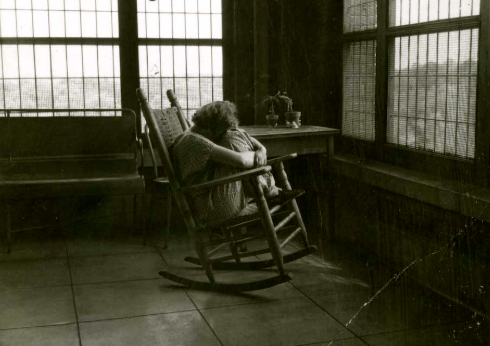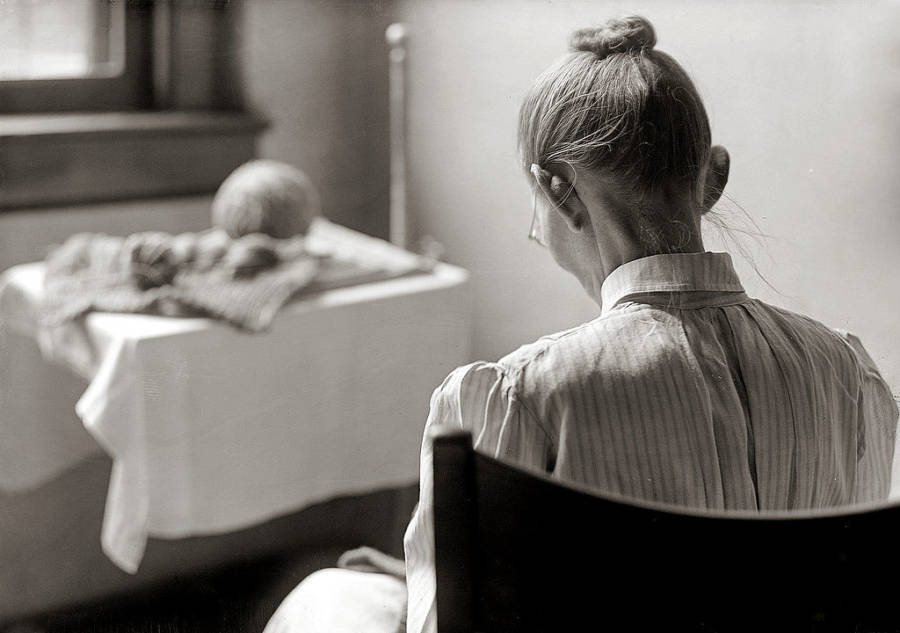How the Rosenhan experiment showed that "it is clear that we cannot distinguish the sane from the insane in psychiatric hospitals."

Duane Howell/The Denver Post via Getty ImagesDr. David Rosenhan. 1973.
What does it mean to be sane? How reliably can even medical professionals distinguish the sane from the insane?
Psychologist Dr. David Rosenhan of Stanford University had long been interested in these age-old questions and, in 1969, devised a unique experiment to put them to the test.
Rosenhan and seven other perfectly sane subjects went undercover inside various psychiatric hospitals from 1969-1972 and acted insane in order to see if the doctors there could tell that they were faking. The doctors could not.
How The Rosenhan Experiment Was Carried Out

Wikimedia CommonsSt. Elizabeths Hospital in Washington, D.C., one of the locations used in the Rosenhan experiment.
The Rosenhan experiment’s eight sane subjects went inside 12 different psychiatric hospitals, all but one state- or federally-run, spread across five U.S. states. These pseudopatients consisted of three women and five men, including Rosenhan himself, whose occupations ranged from actual psychologist to painter.
The participants assumed false names and professions and were instructed to set up appointments at the hospitals and claim that they had been hearing strange voices muttering words like “empty” and “hollow” (these words were meant to evoke an existential crisis, as in, “my life is empty and hollow”). On the basis of these appointments, every single pseudopatient was admitted to the hospital that they contacted.
According to the landmark 1973 report that Rosenhan published about his experiment, On Being Sane in Insane Places, “none of the pseudopatients really believed that they would be admitted so easily.”
Not only was every pseudopatient admitted, but all except one received a diagnosis of schizophrenia (the other diagnosis was “manic-depressive psychosis”). All they had done was feign auditory hallucinations. They exhibited no other symptoms and invented no false details about their lives aside from their names and professions. Yet they were diagnosed with serious psychological disorders.
Once checked into the hospitals and diagnosed, the pseudopatients were on their own. None knew when the doctors would deem them fit for release — or find out that they were faking first.
The Disturbing Results

U.S. National Library of MedicineA patient (not involved with the Rosenhan experiment) at St. Elizabeths Hospital. Circa 1950s.
At the start of the experiment, the patients’ biggest concern was that they would “be immediately exposed as frauds and greatly embarrassed,” according to Rosenhan. But as it turned out, there was no need to worry on this account.
There was a “uniform failure to recognize sanity” in any of the pseudopatients, Rosenhan wrote, and not one of them was ever found out by the hospital staff. The pseudopatients showed no new symptoms and even reported that the strange voices had gone away, yet the doctors and staff continued to believe that their diagnoses were correct.
In fact, hospital staff would observe totally normal behavior on the part of the pseudopatients and characterize it as abnormal. For instance, Rosenhan instructed the pseudopatients to take notes on their experiences. And one nurse who observed this note-taking wrote in a daily report that the “patient engages in writing behavior.”
As Rosenhan saw it, doctors and staff would assume that their diagnosis was correct and work backward from there, reframing everything they observed so that it would be in harmony with that diagnosis:
“Given that the patient is in the hospital, he must be psychologically disturbed. And given that he is a disturbed, continuous writing must be a behavioral manifestation of that disturbance, perhaps a subset of the compulsive behaviors that are sometimes correlated with schizophrenia.”
Likewise, one of the pseudopatients was a man who described his home life by truthfully reporting that he had a warm relationship with his wife, with whom he fought occasionally, and children, who he spanked minimally for misbehavior. But because he was admitted to a psychiatric hospital and diagnosed with schizophrenia, his discharge report stated that “His attempts to control emotionality with his wife and children are punctuated by angry outbursts and, in the case of the children, spankings.”
Had the man not been a patient in a psychiatric hospital, his common, mundane home life surely wouldn’t have been described in such dark tones.
“Diagnoses were in no way affected by the relative health of the circumstances of a pseudopatient’s life,” Rosenhan wrote. “Rather, the reverse occurred: The perception of his circumstances was shaped entirely by the diagnosis.”

Library of Congress/Wikimedia CommonsA patient sits inside St. Elizabeths Hospital. 1917.
And in addition to stubbornly sticking to their diagnoses, hospital staff would treat the pseudopatients coldly. Interactions with the staff ranged from disinterested at best to abusive at worst. Even when the pseudopatients attempted to engage with staff in a friendly, conversational manner, responses were perfunctory (when given at all).
But while hospital staff treated the pseudopatients poorly and never realized they were faking, the actual patients often had no trouble detecting them. When the researchers were able to keep track, 35 out of 118 actual patients blatantly accused the pseudopatients of faking, with some outright stating, “You’re not crazy. You’re a journalist or a professor.”
Nevertheless, the doctors never got wise. The pseudopatients were eventually released — stays ranged from 7 to 52 days, with an average of 19 — but all with the same diagnosis under which they’d been admitted. They were released, however, because doctors decided that their condition was “in remission.”
As Rosenhan wrote:
“At no time during any hospitalization had any question been raised about any pseudopatient’s simulation. Nor are there any indications in the hospital records that the pseudopatient’s status was suspect. Rather the evidence is strong that, once labeled schizophrenic, the pseudopatient was stuck with that label. If the pseudopatient was to be discharged, he must naturally be ‘in remission’; but he was not sane, nor, in the institution’s view, had he ever been sane.”
The Legacy Of The Rosenhan Experiment
“It is clear that we cannot distinguish the sane from the insane in psychiatric hospitals,” Rosenhan wrote at the outset of his report’s conclusion.
Rosenhan theorized that the willingness of the hospitals to admit sane people resulted from what’s known as a “Type 2” or “false positive” error, which results in a greater willingness to diagnose a healthy person as sick than a sick person as healthy. This kind of thinking is understandable to a point: failing to diagnose a sick person usually has more severe consequences than misdiagnosing a healthy one. However, the consequences of the latter can be dire.
Either way, the results of the Rosenhan experiment caused a sensation. People were astonished about the unreliability of psychiatric diagnoses and the ease with which hospital staff had been duped.
However, some researchers criticized the Rosenhan experiment, stating that the pseudopatients’ dishonest reporting of their symptoms made the experiment invalid because patients’ self-reports are one of the cornerstones on which psychiatric diagnoses are built.
But other researchers have affirmed Rosenhan’s methods and results, with some even partially replicating his experiment and coming up with similar conclusions.
Of course, even Rosenhan was not the first American to bring the darker side of the mental health system to light in this way.

Wikimedia CommonsNellie Bly
In 1887, journalist Nellie Bly went undercover in an insane asylum and published her findings as Ten Days in a Mad-House.
Bly too concluded that many of the other patients were just as “sane” as she and had been sent to the asylum unfairly. Bly’s work resulted in a grand jury investigation that attempted to make psychiatric examinations more thorough in an attempt to make sure that less “sane” people were institutionalized.
Almost a century later, Rosenhan showed that the mental health profession still had a long way to go in being able to reliably and consistently distinguish the sane from the insane.
After the results of the Rosenhan experiment were published, the American Psychiatric Association changed the Diagnostic and Statistical Manual of Mental Disorders. The new version of the manual, published in 1980, presented a more thorough list of symptoms for every mental illness and stated that, in order to diagnose a patient with a certain disorder, multiple symptoms had to be present as opposed to just one.
These changes in the manual survive to this day, although it has yet to be conclusively determined whether it has been successful in preventing false diagnoses. Perhaps the Rosenhan experiment could be duplicated today.
New Research Casts Doubt
Because the pseudopatients of the Rosenhan experiment would never be able to talk about their participation and because relatively little had been written authoritatively about the course of the study itself, it became a difficult experiment to discuss and critique — there simply wasn’t much to argue with. However, subsequent research that utilized uncovered documentation from the original experiment eventually found fault with Rosenhan’s study.
In her 2019 book on the Rosenhan experiment, The Great Pretender, journalist Susannah Cahalan cited unearthed primary sources like correspondence, diary entries, and excerpts from Rosenhan’s unfinished book. And such documentation, Cahalan found, actually contradicted the results that Rosenhan published on certain points.
For one, Cahalan claimed that Rosenhan himself, when undercover in an institution as part of his own experiment, told doctors there that his symptoms were quite severe, which would explain why he was so quickly diagnosed. This is significant because it runs counter to Rosenhan’s report, which claimed that he told doctors of some relatively light symptoms, which is precisely what made those doctors’ diagnoses seem like such an overreaction.
Furthermore, when Cahalan was finally able to track down one of the pseudopatients, he summed up his experience inside an institution with one word — “positive” — a stark rebuttal of the horror shows that Rosenhan’s participants had supposedly endured. But Rosenhan allegedly ignored this data when drafting his report.
“Rosenhan was interested in diagnosis, and that’s fine, but you’ve got to respect and accept the data, even if the data are not supportive of your preconceptions,” said the participant in question, Harry Lando.
If such claims are accurate and the Rosenhan experiment didn’t quite prove what it purported to, who knows how the course of psychiatric care in the U.S. may have unfolded in the decades since.
After this look at the Rosenhan experiment, read up on the infamous Milgram experiment and Stanford prison experiment. Then, take a disturbing look inside mental asylums of decades past.






